Mostrar o rexistro simple do ítem
Faster shift-reduce constituent parsing with a non-binary, bottom-up strategy
| dc.contributor.author | Fernández-González, Daniel | |
| dc.contributor.author | Gómez-Rodríguez, Carlos | |
| dc.date.accessioned | 2024-01-23T12:56:13Z | |
| dc.date.available | 2024-01-23T12:56:13Z | |
| dc.date.issued | 2019-10 | |
| dc.identifier.citation | D. Fernández-González y C. Gómez-Rodríguez, «Faster shift-reduce constituent parsing with a non-binary, bottom-up strategy», Artificial Intelligence, vol. 275, pp. 559-574, oct. 2019, doi: 10.1016/j.artint.2019.07.006. | es_ES |
| dc.identifier.issn | 0004-3702 | |
| dc.identifier.issn | 1872-7921 | |
| dc.identifier.uri | http://hdl.handle.net/2183/35077 | |
| dc.description | © 2019. This is the final peer-reviewed manuscript that was accepted for publication at Artificial Intelligence and made available under the CC-BY-NC-ND 4.0 license http://creativecommons.org/ licenses/by-nc-nd/4.0/. This may not reflect subsequent changes resulting from the publishing process such as editing, formatting, pagination, and other quality control mechanisms. The final journal publication is available at https://doi.org/10.1016/j.artint.2019.07.006 | |
| dc.description.abstract | [Absctract]: An increasingly wide range of artificial intelligence applications rely on syntactic information to process and extract meaning from natural language text or speech, with constituent trees being one of the most widely used syntactic formalisms. To produce these phrase-structure representations from sentences in natural language, shift-reduce constituent parsers have become one of the most efficient approaches. Increasing their accuracy and speed is still one of the main objectives pursued by the research community so that artificial intelligence applications that make use of parsing outputs, such as machine translation or voice assistant services, can improve their performance. With this goal in mind, we propose in this article a novel non-binary shift-reduce algorithm for constituent parsing. Our parser follows a classical bottom-up strategy but, unlike others, it straightforwardly creates non-binary branchings with just one transition, instead of requiring prior binarization or a sequence of binary transitions, allowing its direct application to any language without the need of further resources such as percolation tables. As a result, it uses fewer transitions per sentence than existing transition-based constituent parsers, becoming the fastest such system and, as a consequence, speeding up downstream applications. Using static oracle training and greedy search, the accuracy of this novel approach is on par with state-of-the-art transition-based constituent parsers and outperforms all top-down and bottom-up greedy shift-reduce systems on the Wall Street Journal section from the English Penn Treebank and the Penn Chinese Treebank. Additionally, we develop a dynamic oracle for training the proposed transition-based algorithm, achieving further improvements in both benchmarks and obtaining the best accuracy to date on the Penn Chinese Treebank among greedy shift-reduce parsers. | es_ES |
| dc.description.sponsorship | This work has received funding from the European Research Council (ERC), under the European Union's Horizon 2020 research and innovation programme (FASTPARSE, grant agreement No 714150), from the ANSWER-ASAP project (TIN2017-85160-C2-1-R) from MINECO, and from Xunta de Galicia (ED431B 2017/01). | es_ES |
| dc.description.sponsorship | Xunta de Galicia; ED431B 2017/01 | es_ES |
| dc.language.iso | eng | es_ES |
| dc.publisher | Elsevier B.V. | es_ES |
| dc.relation | info:eu-repo/grantAgreement/EC/H2020/714150 | es_ES |
| dc.relation | info:eu-repo/grantAgreement/AEI/Plan Estatal de Investigación Científica y Técnica y de Innovación 2017-2020/TIN2017-85160-C2-1-R/ES/AVANCES EN NUEVOS SISTEMAS DE EXTRACCION DE RESPUESTAS CON ANALISIS SEMANTICO Y APRENDIZAJE PROFUNDO | es_ES |
| dc.relation.isversionof | https://doi.org/10.1016/j.artint.2019.07.006 | |
| dc.relation.uri | https://doi.org/10.1016/j.artint.2019.07.006 | es_ES |
| dc.rights | Atribución-NoComercial-SinDerivadas (CC BY-NC-ND) | |
| dc.rights.uri | https://creativecommons.org/licenses/by-nc-nd/4.0/deed.es | |
| dc.subject | Automata | es_ES |
| dc.subject | Natural language processing | es_ES |
| dc.subject | Computational linguistics | es_ES |
| dc.subject | Parsing | es_ES |
| dc.subject | Constituent parsing | es_ES |
| dc.title | Faster shift-reduce constituent parsing with a non-binary, bottom-up strategy | es_ES |
| dc.type | info:eu-repo/semantics/article | es_ES |
| dc.rights.access | info:eu-repo/semantics/openAccess | es_ES |
| UDC.journalTitle | Artificial Intelligence | es_ES |
| UDC.volume | 275 | es_ES |
| UDC.startPage | 559 | es_ES |
| UDC.endPage | 574 | es_ES |
Ficheiros no ítem
Este ítem aparece na(s) seguinte(s) colección(s)
-
GI-LYS - Artigos [43]
-
OpenAIRE [266]






